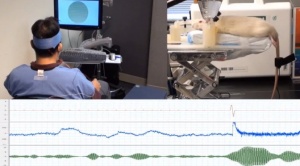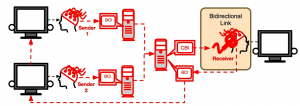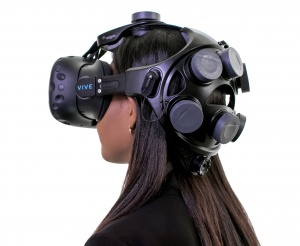Brain-to-Brain Interface
Brain-to-brain interface (BBI) refers to interface technology that allows for communication between biological brains. These interfaces typically employ a brain-machine interface (BMI; also called brain-computer interface or BCI) to establish a connection from one brain to a machine, which then transmits the received neural information to another brain. Brain-to-brain interfaces have been utilized among non-human animals, and recent developments have also allowed for successful communication between humans and non-human animals, as well as across human brains.
Research in BBIs
Recent work in brain-to-brain interfaces include examples of brain-to-brain communication between animals of the same species (such as between rats), cross-species communication (such as between a rat and a human), and communication between two or more humans. Major milestones in this field of research are detailed below.
Novel Research
Brain-to-brain interfaces between rats were first introduced in 2013 by Miguel Nicolelis at Duke University. [1] Through this investigation, two rats were taught to press either a right or left lever, and then a brain-machine interface was used to record cortical and sensorimotor signals containing information on which lever one rat pressed, known as the "encoder" rat. The information was then passed through and decoded by a computer, and subsequently transmitted to the brain of the second rat, known as the "decoder" rat. The overall goal of this procedure was to teach the "decoder" rat to press the correct lever after receiving the brain signals of its counterpart. As noted by the study, the receiving rat learned to press the correct lever seven out of ten times.[2]
Despite Nicolelis's success, the study received mixed reviews. Neuroscientist Ron D. Frostig at the University of California, Irvine, described it as “an amazing paper” that demonstrated information could be transferred from one brain to another in real time, while Andrew B. Schwartz, a neuroscientist at the University of Pittsburgh, stated the study was “very simplistic”.[3]

Intra-species Coupling
In 2013, associate professor of radiology, Seung-Schik Yoo, led a team of Harvard researchers in the development of the first interspecies BBI between human and rat subjects. Using a non-invasive method of BBI, the study used a flashing light to generate a signal from the human brain. The generated signal was then transmitted to the brain of an anesthetized rat, causing the animal to move its tail. This was done by attaching a "focused ultrasound machine" (FUS) machine to the rat designed to stimulate the specific lobes of the brain associated with tail movement. In parallel, the BBI technology was used to read the neural signals of a human using an electroencephalogram (EEG). By connecting these two systems, the flashing light that the human participant looked at triggered a burst of ultrasound waves connected to the rat’s brain, causing it to move its tail.[4] Further investigation is currently being conducted in order to send more sophisticated messages through BBI, as well as exploring the idea of 'neural coupling.'[5]
Human-Human Connections
In 2013, researchers at the University of Washington established brain-to-brain communication in six participants. Described as the “first direct brain-to-brain interface in humans,” participants were asked to play a cooperative computer game after being paired up with one another. Within each group, one player acted as the “sender” and the other as the “receiver.” The players were separated into different buildings on campus, located one mile apart. During the experiment, the “sender” was able to see the game on a computer screen but had no control over the in-game mechanics. On the other hand, the "receiver" was unable to see the game, but had a touchpad that could be used to interact with the game. Using electroencephalography (EEG), electrical brain activity containing the motor information to operate the cannon was recorded from the “sender” and sent to a brain-computer interface server. Transcranial magnetic stimulation (TMS) was then utilized; the information was transmitted to a TMS server and created stimulation of specified brain regions in the “receiver,” causing motor movement of the hand in the receiving participant to click or move the mouse in the game.[6]

BrainNet
A study published in Nature in 2019 by a joint collaboration between researchers at the University of Washington & Carnegie Mellon University introduced BrainNet. Described as the “first multi-person non-invasive direct brain-to-brain interface for collaborative problem solving” and “a next-generation BBI that addresses many of the limitations of past BBIs,” BrianNet is designed to allow for brain-to-brain communication on a collaborative task between more than two participants. The study specifically involved three human subjects playing a game similar to Tetris, in which information from the brains of two “senders” was recorded through the use of EEG and transmitted to the brain of the “receiver” over the internet through a brain-computer interface based on TMS.[7]
The authors of the paper identified three ways BrainNet improved upon prior human brain-to-brain interfaces:
- “BrainNet expands the scale of BBIs to multiple human subjects working collaboratively to solve a task.”
- “BrainNet is the first BBI to combine brain recording (EEG) and brain stimulation (TMS) in a single human subject, eliminating the need to use any physical movements to convey information”
- “Using only the information delivered by BrainNet, Receivers are able to learn the reliability of information conveyed to their brains by other subjects and choose the more reliable sender. This makes the information exchange mediated by BrainNet similar to real-life social communication, bringing us a step closer to a ‘social network of brains’.”
Possible Uses

While greater research is necessary, possible uses for this technology have already started to arise in mainstream culture.
Medicine
BBI technology has already shown promising results in the future of medical devices. Neural implants, such as cochlear implants, bypass the auditory apparatus and allow a person to hear sounds from outside by converting them into electrical signals that directly reach the brain. Furthermore, some prosthetics, like artificial arms and legs, have already been made to move in response to a patient's thoughts.[9]
Other possible innovations through BBI technology include restoring function to people disabled by neuromuscular disorders such as cerebral palsy, strokes, or spinal cord injuries. [10] However, experts agree that in order for greater progress to be made in the use of this technology, "day-to-day and moment-to-moment reliability of BCI performance must be improved". At the moment, the sophistication of BCIs do not approach the reliability of natural functions.
Automotive
BCI-enabled automobiles stand to play an important role in the development of safer vehicles. While car accidents are one of the biggest causes of death worldwide, BCI-enabled vehicles could help prevent these accidents by recognizing thoughts in a driver's mind and taking a decision faster than the driver could. Nissan, an automobile manufacturer, is already conducting research on a system that would allow the vehicle to slow down or turn the steering wheel 0.2 to 0.5 seconds faster than the driver could.[11]
In addition, studies have shown that EEG signals could potentially be used in car control applications, allowing for individuals with limited mobility, such as those with locked-in disorders, to operate vehicles while also supporting healthy individuals in safe driving. [12]
Office
BCI technology could also be used in the office place in multiple ways. For example, BCI could detect when attention levels are too low and could trigger an alert to focus, or even adapt the lighting in the room to affect a person. A startup named "Muse" is already developing tools that could do this. Their sensing startup can give real-time information on brain activity and give insight on engagement levels, which could help individuals complete their tasks.[13]
Additionally, BCI technology has the ability to help "situational disabled’ users, or those who are able to use their hands, feet, gaze, etc., to add an extra control to their abilities. One example of this would be a pilot able to better modulate their hand-eye coordination and vision. [14] Through the development of these technologies a greater variety of fields would become available to the average person as the degree of skill required to complete specific tasks is reduced.
Gaming
Several gaming companies have also started to utilize this technology to make their games more immersive. Game developers Valve and Neurable have already made devices. Valve is in development for a passive interface, rather than implanted, that controls a game using a wearer's mind. Neurable, on the other hand, currently already has a device that can control an escape game using sensors in a cap, but has since moved on to military applications.[15]
Ethical Considerations
While brain-to-brain interface technology is still in an infantile stage of research, several concerns have been identified in the discussion of ethical of brain-to-brain interface use and integration.
Autonomy and Privacy
Elisabeth Hildt from the Center for the Study of Ethics in the Professions at the Illinois Institute of Technology in Chicago has discussed various issues with multi-person BBIs related to autonomy, privacy, agency, accountability, and identity. Concerning autonomy in brain-to-brain interfaces, there is a risk of information taken from individual brains being transmitted and shared within the network without the consent of the individuals involved. Privacy issues may arise if brain information is recorded and used from a person unaware or against the information being recorded and distributed. In addition, those receiving brain information in a network may also have things they do not wish to receive. It is also unclear whether receivers in BBI networks could be harmed through their use of these technologies, as their brains are affected by the signals being transmitted and there could exist some risk of overstimulation.[16]
Biological Enhancements
Other scientists have discussed the ethical concern of biological enhancement. Advanced brain-to-brain interface technology could be used to modify human cognition through the potential enhancement of the rate of knowledge or skill acquisition. Such enhancement could be useful for learning, yet these technologies would likely be expensive and only available to certain groups of people, highlighting problems of social inequities in education and other areas.[17]
Cross-Species Neural Interfacing
It is also important to consider the ethical implications of cross-species neural interfacing. The UK Academy of Medical Sciences has speculated on this topic, in the report, "Animals Containing Human Material," where they identify a category of research as, "Substantial modification of an animal’s brain that may make the brain function potentially more ‘human-like', particularly in large animals."[18] The possibility of conducting this research is well within the scope of brain-to-brain interface technology. Scientists at Harvard Medical School have already conducted the first interspecies brain interfacing study, by using EEG to take recorded signals from a human scalp, and use them to stimulate movement in the tail of an anesthetized rat. They have also suggested the possibility of using this technology to transmit neural stimulation from non-human animals to humans, with the possibility of enhancing human sensory systems. Modifying the human brain to have animal-like functions and instincts presents a need for further consideration of ethical concerns before moving forward.[19]
Military Use
There are also concerns with brain-to-brain interfaces, combined with brain-machine interfaces, being utilized in a military setting. The Defense Advanced Research Projects Agency (DARPA) is one of several military-affiliated groups with an interest in BBIs[20]; researchers at Rice University exploring applications of BBIs and BMIs received $8 million in funding from DARPA in 2021, an addition to $18 million received in 2018.[21] Use of these technologies in the military has raised concerns pertaining to agency and identity. [17]
References
- ↑ "Laboratory of Dr. Miguel Nicolelis." Nicolelislab. Web.
- ↑ Pais-Vieira, M., Lebedev, M., Kunicki, C. et al. A Brain-to-Brain Interface for Real-Time Sharing of Sensorimotor Information. Sci Rep 3, 1319 (2013). https://doi.org/10.1038/srep01319
- ↑ Gorman, J. (2013, February 28). In a First, Experiment Links Brains of Two Rats. The New York Times. https://www.nytimes.com/2013/03/01/science/new-research-suggests-two-rat-brains-can-be-linked.html
- ↑ Yoo S., Kim H., Filandrianos E., Taghados S. J., Park S. (2013, April 3). Non-Invasive Brain-to-Brain Interface (BBI): Establishing Functional Links between Two Brains. Plos One. https://journals.plos.org/plosone/article?id=10.1371/journal.pone.0060410
- ↑ Saalfield, P. (2014, April). Fusing Faculties of Mind. Harvard Magazine. https://harvardmagazine.com/2014/03/fusing-faculties-of-mind
- ↑ Rao, R. P. N., Stocco, A., Bryan, M., Sarma, D., Youngquist, T. M., Wu, J., & Prat, C. S. (2014). A Direct Brain-to-Brain Interface in Humans. PLOS ONE, 9(11), e111332. https://doi.org/10.1371/journal.pone.0111332
- ↑ Jiang, L., Stocco, A., Losey, D.M. et al. BrainNet: A Multi-Person Brain-to-Brain Interface for Direct Collaboration Between Brains. Sci Rep 9, 6115 (2019). https://doi.org/10.1038/s41598-019-41895-7
- ↑ Neurospec AG. (n.d.). DSI-VR300 [Digital image]. Retrieved April 08, 2021, from https://www.neurospec.com/Products/Details/1077/dsi-vr300
- ↑ Thomas, D. (2019, September 11). Brain-computer interface: Huge potential benefits and formidable challenges. Retrieved April 09, 2021, from https://www.news-medical.net/news/20190911/Brain-computer-interface-huge-potential-benefits-and-formidable-challenges.aspx
- ↑ Shih, Jerry J, Dean J Krusienski, and Jonathan R Wolpaw. "Brain-computer Interfaces in Medicine." Mayo Clinic Proceedings. Mayo Foundation, Mar. 2012. Web. 09 Apr. 2021.
- ↑ Joshi, N. (2019, September 1). Exploring the benefits and risks of brain computer interface. Retrieved April 09, 2021, from https://www.allerin.com/blog/exploring-the-benefits-and-risks-of-brain-computer-interface
- ↑ Pais-Vieira, Miguel, Mikhail Lebedev, Carolina Kunicki, Jing Wang, and Miguel A. L. Nicolelis. "A Brain-to-Brain Interface for Real-Time Sharing of Sensorimotor Information." Nature News. Nature Publishing Group, 28 Feb. 2013. Web. 09 Apr. 2021.
- ↑ Gonfalonieri, A. (2020, October 06). What brain-computer interfaces could mean for the future of work. Retrieved April 09, 2021, from https://hbr.org/2020/10/what-brain-computer-interfaces-could-mean-for-the-future-of-work
- ↑ "BCI for Games: A ‘State of the Art’ Survey - Springer." Web. 9 Apr. 2021.
- ↑ Hein, J. (2021, February 17). The benefits and risks of neural interfaces. Retrieved April 09, 2021, from https://www.bangkokpost.com/tech/2069607/the-benefits-and-risks-of-neural-interfaces
- ↑ Hildt, E. (2019, November 5). Multi-Person Brain-To-Brain Interfaces: Ethical Issues. Frontiers in Neuroscience. https://doi.org/10.3389/fnins.2019.01177
- ↑ 17.0 17.1 Trimper, J. B., Wolpe, P. R., Rommelfanger, K. S. (2014, February 12). When “I” becomes “We”: ethical implications of emerging brain-to-brain interfacing technologies. Frontiers in Neuroengineering. https://doi.org/10.3389/fneng.2014.00004
- ↑ (2011, July). Animals containing human material. The Academy of Medical Sciences. https://acmedsci.ac.uk/file-download/35228-Animalsc.pdf
- ↑ Hildt, E. (2015, February 25). What will this do to me and my brain? Ethical issues in brain-to-brain interfacing. Frontiers in Systems Neuroscience. https://www.ncbi.nlm.nih.gov/pmc/articles/PMC4340163/
- ↑ Martone, R. (2019, October 29). Scientists Demonstrate Direct Brain-to-Brain Communication in Humans. Scientific American. https://www.scientificamerican.com/article/scientists-demonstrate-direct-brain-to-brain-communication-in-humans/
- ↑ Boyd, J. (2021, January 25). Brain-to-brain communication demo receives DARPA funding. Rice University News and Media Relations. https://news.rice.edu/2021/01/25/brain-to-brain-communication-demo-receives-darpa-funding/